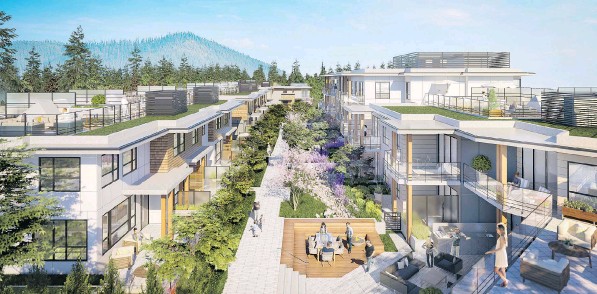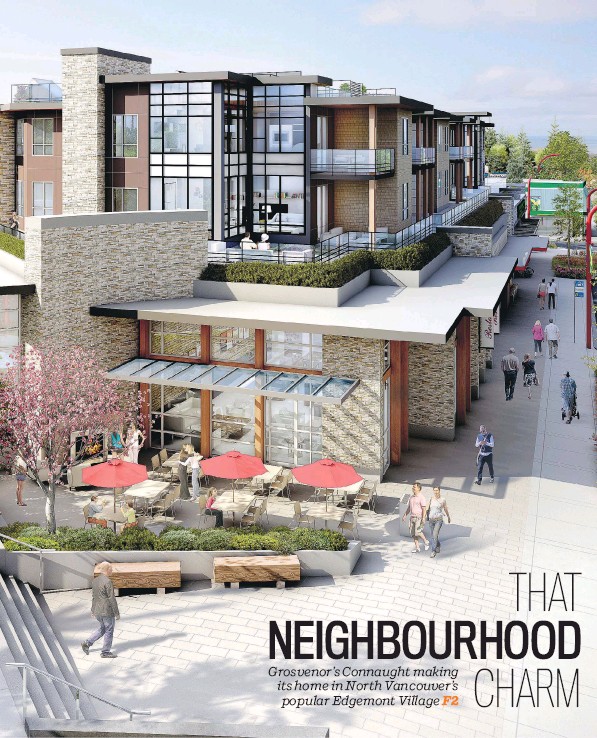Grosvenor’s Connaught making its home in North Vancouver’s popular Edgemont Village
Simon Briault
The Vancouver Sun

Connaught will comprise a total of 82 homes: 23 town houses and 59 apartments

All homes at Connaught will have outdoor living areas, some ranging up to 1,000 square feet

Connaught kitchens will feature imported Italian cabinetry, soft-close doors, under-cabinet lighting and polished stone countertops

Connaught homes offer buyers plenty of premium amenities

Interiors at Connaught are the work of interior designer Scott Trepp

The two and three bedroom homes that remain for sale range between 1,097 and 1,528 square feet
Connaught
Project location: 3230 Connaught Crescent, Edgemont Village, North Vancouver
Project size: 23 townhomes and 59 apartments. Homes that are still available range between 1,097 and 1,528 square feet and are priced at $1.38 million to $2.26 million.
Developer: Grosvenor
Architect: Rositch Hemphill Architects
Interior designer: Scott Trepp
Sales centre: 3044 Edgemont Boulevard, North Vancouver
Hours: noon — 5 p.m.
Telephone: 604-699-0036
Website: connaughtliving.com
Occupancy: Spring 2018
People love Edgemont Village. It’s consistently ranked among North Vancouver’s favourite neighbourhoods and its popularity is one of the reasons why those behind Connaught, a new development of townhomes and apartments to be located just off Edgemont Boulevard, have had no problems generating interest from buyers.
Negar Hadavi is one of them. A director at a company that sells natural wellness products, she and her husband bought a three-bedroom, two-level townhome at Connaught and will be taking possession in early 2018 when the 82-home development is complete.
“My husband is an entrepreneur who owns a spin studio and one of the reasons we bought here is that we’re opening our second location only two minutes away from the development,” Hadavi said. “There’s not much you can get in the area now for $1.5 to $2 million. Instead of buying an old house that we would have to tear down and rebuild, we were looking for a more urban type of living arrangement. It’s concrete, it has air conditioning and it has a lot of premium amenities that we would have wanted if we had built our own place.”
The developers, a company called Grosvenor, have a 300-year history and started out building homes in the West End of London, England. Developments in Vancouver, where the company has been operating for more than 40 years, include The RISE along the Cambie Corridor, 15West in North Vancouver, 5955 Balsam in Kerrisdale and a development in West Vancouver called Grosvenor Ambleside.
“We have a strong reputation for quality, and seek opportunities to create, to invest in and to manage properties and places that contribute to the success of a city,” said Michael Ward, senior vice-president of development for Grosvenor Americas. “Grosvenor aims to make long-term contributions to places like Edgemont Village by using creative design and high-quality building methods in all our projects.”
At Connaught, this translates into outdoor living areas for every home – some as large as 1,000 square feet – a landscaped rooftop courtyard equipped with a barbecue, a fire pit, seating and a natural kid’s play area, and interiors that are reminiscent of a single-family home.
“It was important that the homes fit within the context of Edgemont Village, so Connaught features comfortable, spacious living spaces that lend to the feel of a single-family home,” Ward said. “This is echoed throughout the homes, from the size of the rooms and extent of the storage space, to ample counter space and extra-large sinks in the kitchen. Downsizers will notice single-family home elements are incorporated into each Connaught home and young families will feel the benefits of generous, thoughtfully designed spaces.”
Kitchens feature imported Italian wood cabinetry, soft-close door and drawer mechanisms and under-cabinet lighting. Bosch appliance packages include five-burner gas cooktops, integrated dishwashers and fridge freezers, and stainless steel exhaust hoods. There are polished quartz countertops complemented by marble slab backsplashes, under-mount stainless steel sinks with polished chrome kitchen faucets by Kohler and integrated garbage/recycling centres.
Bathrooms feature imported Italian wood vanities, over-sized marble tile for flooring, shower and tub surrounds. There are four-inch profile polished quartz countertops and under-mount sinks in bathrooms, including double vanity sinks in all master bathrooms. The chrome faucets are by Kohler, there are rain shower heads and polished chrome hand-helds in all master ensuites, and all bathrooms feature dual-flush toilets.
So the luxury is all there, but both Hadavi and Ward both come back to the location of Connaught when asked what really makes it special.
“Location has definitely been a key selling point for the project,” Ward said. “Edgemont Village offers the feel of a small community in a spectacular setting. It’s not uncommon here for business owners to know their patrons by name. Buyers benefit from the unique collection of established and family-owned businesses in the area, and residents will also benefit from a full-service Thrifty Foods amongst an array of boutique shops and services at Connaught.”
Hadavi explained that she grew up in North Vancouver and still has a strong attachment to the area. She and her husband were married two years ago and are looking to raise a family soon.
“Another reason we like the area is the school system – I obviously know it very well. Edgemont is a residential area that feels really homey. It’s safe and quiet, but also only a 15-minute drive to downtown and it’s probably the only suburb of Vancouver I would consider living in. All my friends live on the North Shore and all my mum’s friends live there too so it just feels like home. I love Edgemont Village. It’s my happy place.”
Homes at Connaught have been selling fast. The two- and three-bedroom homes that are still available range between 1,097 and 1,528 square feet and are priced between $1.38 million to $2.26 million.
Connaught, By the Numbers:
15: in minutes, driving distance to downtown Vancouver
23: number of townhomes at Connaught
59: number of apartments at Connaught
1,000: in square feet, the size of the largest outdoor area
1,528: in square feet, the size of the largest Connaught homes still on offer
© 2016 Postmedia Network Inc.








